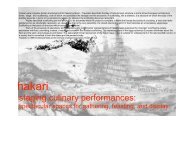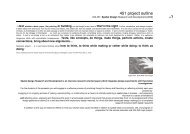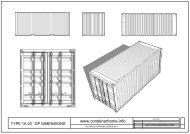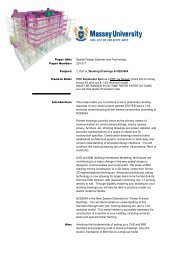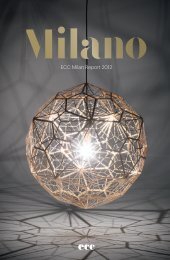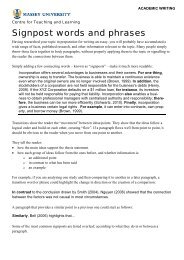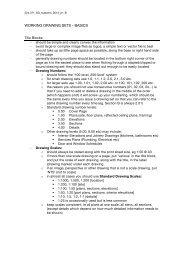Assignment 1: A room of one's own: - Spatial Design@Massey
Assignment 1: A room of one's own: - Spatial Design@Massey
Assignment 1: A room of one's own: - Spatial Design@Massey
You also want an ePaper? Increase the reach of your titles
YUMPU automatically turns print PDFs into web optimized ePapers that Google loves.
Massey University College <strong>of</strong> Creative Arts<br />
2 March 2009<br />
Sven Mehzoud<br />
Stephanie Schicker<br />
Mike Caldwell, Rain Drop<br />
Paper title:<br />
<strong>Spatial</strong> Design Studio I<br />
Paper Number: 224.251<br />
<strong>Assignment</strong> 1:<br />
A <strong>room</strong> <strong>of</strong> one’s <strong>own</strong>:<br />
collecting space – personal space<br />
Hand-in Date: Tuesday 31 March 5:00pm<br />
Introduction:<br />
Most everyday life situations incorporate ritualized elements.<br />
Our waking-up rituals, mealtime rituals, greeting rituals,<br />
parting rituals, and so on moderate most <strong>of</strong> our ongoing<br />
social life. Understanding these rituals can help us more<br />
successfully perform these basic human interactions.<br />
Richard Schechner<br />
In ‘Performance Studies: An Introduction’<br />
This assignment introduces you to the concept <strong>of</strong> ‘ritual’ as a<br />
way to understand inhabitation and its relationship to our lived in<br />
environment. One can begin to distinguish different kinds <strong>of</strong><br />
rituals; while all rituals share a repetitive character, they can be<br />
distinguished by the public or private spaces in which they occur.<br />
There are also formalized rituals, a powhiri, the ceremony <strong>of</strong><br />
encounter for instance, and informal equivalents <strong>of</strong> welcomes,<br />
amongst friends or at work perhaps. Most <strong>of</strong> the time we aren’t<br />
consciously aware <strong>of</strong> the rituals we take part in, they are more<br />
like recurring behaviours, resulting in ‘agreements <strong>of</strong> coexistence’.<br />
For some, rituals also occur on a most intimate level,<br />
at home, in one’s private life.<br />
Mike Cadwell, Rain drop - Ro<strong>of</strong><br />
PERSONAL SPACE<br />
The starting point <strong>of</strong> this project is an introspective look at one <strong>of</strong><br />
your personal everyday life situation. You will be allocated one<br />
<strong>of</strong> the following activities that will serve as the basis for a design<br />
<strong>of</strong> ‘a <strong>room</strong> <strong>of</strong> your <strong>own</strong>’: sleeping; cleansing; reading; eating.
Project One_ 224.251 cont.<br />
RITUAL<br />
You will explore the concept <strong>of</strong> ritual as a way to understand<br />
private inhabitation, and its relationship to space. Observe the<br />
way the activity/situation structures how we use and interact with<br />
space and consider the objects we use and are surrounded by<br />
daily and how they might help signify and structure the ritualized<br />
experience.<br />
THE SENSES<br />
The following readings ‘a natural history <strong>of</strong> the senses’,<br />
‘questions <strong>of</strong> perception’ and ‘the eye <strong>of</strong> the skin’ serve as a way<br />
into the collecting <strong>of</strong> spatial fragments, and the subsequent<br />
designing <strong>of</strong> your personal space. Choose elements <strong>of</strong> the<br />
reading and translate them into spatial qualities such as form,<br />
light, materiality and sound through the making <strong>of</strong> models and<br />
drawings.<br />
SCRIPT [integrated into visual narrative]<br />
Draw out a 200 word text [max] about the design that you are<br />
producing using your research, models and drawings, to<br />
support the visual narrative that is to communicate the<br />
ritualized experience <strong>of</strong> the designed space.<br />
Eno / Mills, Third Uncle<br />
Project Requirements:<br />
Individually design a personal space – by applying research,<br />
model making, drawing / Photoshop, other. Communicate your<br />
design through a visual narrative and a final model. The hand in<br />
has to include:<br />
1. Visual presentation <strong>of</strong> research into personal space and<br />
ritual explorations<br />
2. Developmental work [models, drawings] and workbook in<br />
order to understand and assess the depth and breadth <strong>of</strong><br />
your engagement, research, concept and design<br />
development and its iterative and reflective processes.<br />
3. Text, incorporated into visual narrative or model<br />
This project is run conjointly with 224.261 and 224.271:<br />
4. Final visual narrative [261]<br />
5. Final model [271]
Project One_ 224.251 cont.<br />
Assessment:<br />
The project will be assessed to the extent that it:<br />
- displays a thorough and creative working process,<br />
including the analysis and translation <strong>of</strong> spatial qualities<br />
into 2D and 3D media<br />
- demonstrate an ability to creatively develop a concept as a<br />
response to a spatial design brief<br />
- demonstrates appropriate levels <strong>of</strong> technical competency<br />
<strong>of</strong> writing, drawing and making, related to spatial design<br />
practice<br />
- exhibits a good level <strong>of</strong> design resolution by translating a<br />
concept into a final design proposal<br />
Learning Outcomes:<br />
The student should be able to:<br />
- apply basic research and documentation methods for the<br />
investigation <strong>of</strong> existing spaces and activities<br />
- be familiar with basic spatial design processes for the<br />
development <strong>of</strong> a concept and design<br />
- develop creative responses to communicate spatial ideas<br />
- present a spatial investigation and design proposal in a<br />
variety <strong>of</strong> media, and to well resolved and considered<br />
degree<br />
Procedure and Timetable:<br />
week 1<br />
Mon 23 February<br />
9:00 Intro to <strong>Spatial</strong> Design Programme and Vertical<br />
Project<br />
Wed 25 February<br />
3:30 Vertical Project Banquet Welcome<br />
week 2<br />
Mon 2 March<br />
9:00 Introduction <strong>Assignment</strong> 1<br />
Allocation <strong>of</strong> activities and research into personal<br />
ritual – prepare presentation for week 3<br />
Wed 4 March<br />
9:00 Modeling exercise; bring materials and tools<br />
noon Self directed / <strong>of</strong>fice hours<br />
Independent: develop second model and bring to<br />
class for Monday Week 3 – 224.261<br />
week 3<br />
Mon 9 March<br />
9:00 Visual presentation <strong>of</strong> personal ritual research<br />
possibly consisting <strong>of</strong> series <strong>of</strong> photographs,<br />
drawings, text – group discussion<br />
Wed 11 March<br />
9:00 Drawing exercise – plans and sections<br />
noon Self directed / <strong>of</strong>fice hours<br />
Independent: develop your concept and design<br />
for Monday tutorial session in preparation for<br />
Interim Presentation [Models, drawings, material<br />
studies, precedent examples<br />
week 4<br />
Mon 16 March<br />
9:00 Concept Development / designing <strong>of</strong> space
Project One_ 224.251 cont.<br />
Wed 18 March<br />
9:00 Interim Presentation<br />
Independent: Develop design, visual narrative<br />
and final model<br />
week 5<br />
Mon 23 March<br />
9:00 1 on 1 tutorials, designing <strong>of</strong> space continued<br />
Wed 25 March<br />
9:00 Model making for final design in 10B12 and<br />
workshop<br />
noon Self directed / <strong>of</strong>fice hours<br />
Independent: Finalise design, visual narrative<br />
and model<br />
week 6<br />
Mon 30 March<br />
9:00 1 on 1 Tutorial, finalise presentation<br />
Tue 31 March<br />
5:00 Hand in <strong>Assignment</strong> 1 [pin up]<br />
Wed 1 April<br />
9:00 Presentations <strong>Assignment</strong> 1<br />
[-3:00pm]<br />
week 7<br />
Mon 6 April<br />
9:00 Introduction <strong>Assignment</strong> 2<br />
References:<br />
Ackerman, D. (1995). A natural History <strong>of</strong> the Senses.<br />
New York: Vintage Books. [reading]<br />
Bell, C. (1992). Ritual Theory, Ritual Practice. New York,<br />
Oxford: Oxford University Press.<br />
Blauvelt, A. (2003). Strangely familiar: design and<br />
everyday life. Minneapolis: Walker Art Center.<br />
Bloomer, K.C. & Moore, C. (1977). Body, memory,<br />
architecture. New Haven: Yale Univ. Press.<br />
Brooker, G. and Stone, S. (2004). Re-readings. London:<br />
Riba Enterprises.<br />
Cadwell, M. (1996). Small Buildings: Pamphlet<br />
Architecture No17. New York: Princeton Arch. Press<br />
Ching, F.D.K. (1979/96). Architecture: Form, Space and<br />
Order. New York: Van Nostrand Reinhold.<br />
Ching, F.D.K. (1987). Interior Design illustrated New<br />
York: Van Nostrand Reinhold<br />
Cline, A. (1997). A Hut <strong>of</strong> <strong>one's</strong> <strong>own</strong>: Life outside the<br />
Circle <strong>of</strong> Architecture. Cambridge, Mass.: MIT Press.<br />
Eno, B. (1986). More dark than Shark / Eno & Mills.<br />
London: Faber and Faber.<br />
Friedman, J.B. (1980). Creation in Space: a course in the<br />
fundamentals <strong>of</strong> architecture. Dubuque: Kendall/ Hunt.
Project One_ 224.251 cont.<br />
Harris S. & Berke, D. (1997). Architecture <strong>of</strong> the everyday.<br />
New York: Princeton Arch. Press.<br />
Hejduk, J. etal (Eds) (1988). Education <strong>of</strong> an Architect.<br />
New York: Rizzoli.<br />
Holl, S. et al. (2006). Questions <strong>of</strong> Perception:<br />
Phenomenology <strong>of</strong> Architecture. San Francisco, CA:<br />
William Stout. [reading]<br />
Holl, S. (2000) Parallax. Basel: Birkhäuser.<br />
Holl, S. (2002). Idea and Phenomenon. Baden: Lars<br />
Müller.<br />
Lidwell, W., Holden, K., Butler, J. (2003) Universal<br />
Principles <strong>of</strong> Design. Gloucester, Mass.: Rockport.<br />
Lyndon, D. and Moore, C. (1994). Chambers for a<br />
Memory place. Cambr. Mass.: MIT Press.<br />
Malnar, J.M. and Vodvarka, F. (1992). The interior<br />
Dimension: theoretical approach to enclosed space.<br />
New York: Van Nostrand Reinhold.<br />
Malnar, J.M. and Vodvarka, F. (2004). Sensory Design.<br />
Minneapolis: Minnesota University Press.<br />
[recommended reading]<br />
McGrath, B. and Gardner, J. (2007). Cinemetrics:<br />
Architectural Drawing today. London: Wiley.<br />
Pallasmaa, J. (2005). The eyes <strong>of</strong> the skin: Architectur<br />
<strong>of</strong> the senses. Chichester: Wiley-Academy. [reading]<br />
Porter, T. (2004). Archispeak: an illustrated Guide to<br />
architectural Design Terms. New York: Spon Press.<br />
Schechner, R. (2002). Performance Studies: an<br />
Introduction. London: Routledge.<br />
Woolf, V. (1981). A Room <strong>of</strong> <strong>one's</strong> <strong>own</strong>. New York:<br />
Harcourt Brace Jovanovich.<br />
Zumthor, P. (1998). Thinking architecture. Basel:<br />
Birkhauser.<br />
Contact:<br />
Sven Mehzoud (Y2 coordinator), Office: 10B15, 04 801 57 99 extn 6668,s.a.mehzoud@massey.ac.nz



